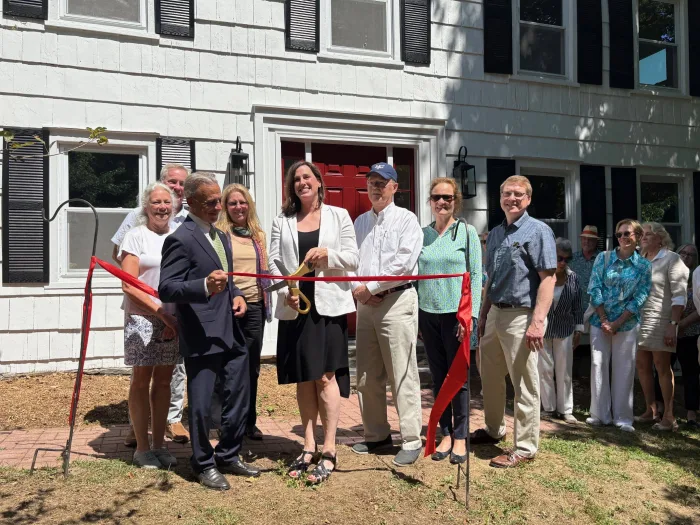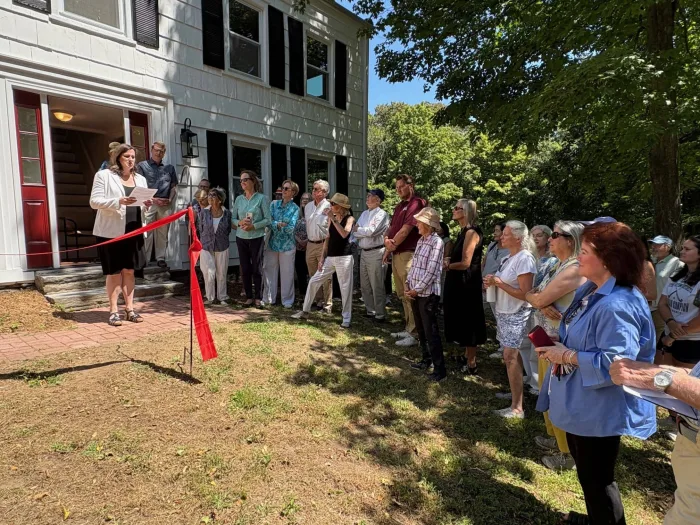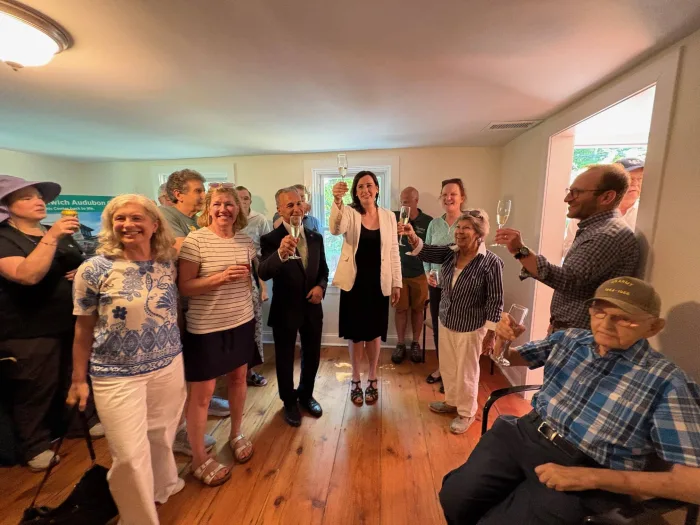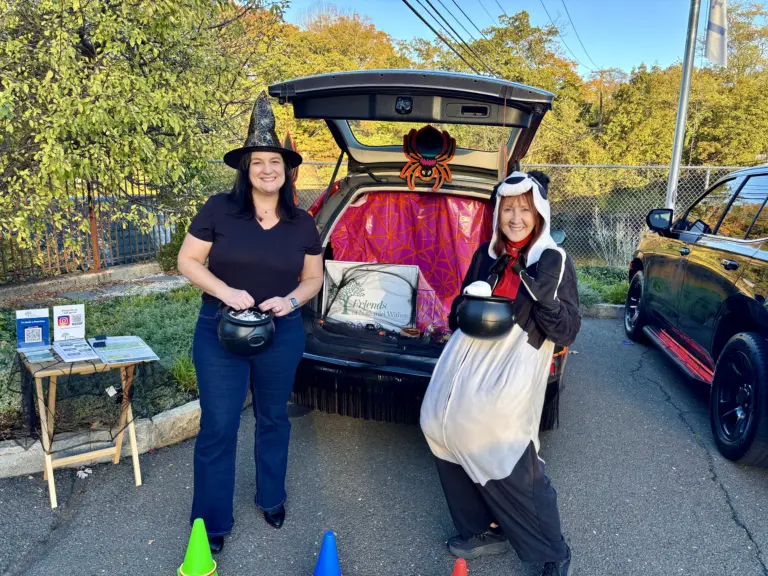
By Anne W. Semmes
Tuesday there was an impressive gathering of Town officials, National Audubon officials, and nonprofit organization leaders for a ribbon cutting before a white clapboard colonial in backcountry to celebrate its restoration, as located on property given to the Greenwich Audubon Center the year of its founding in 1943. “We stand here today to celebrate the re-opening of the Mead House, a home that has been a part of the community since 1746,” welcomed Rochelle Thomas, executive director of the Audubon Center.
Yes, built by Zebediah Mead as one of only three remaining pre-revolutionary houses on John Street between Riversville and Round Hill Roads, inherited by the Clovis family then given to Audubon Greenwich.
“We take pride in conservation and preservation,” addressed First Selectman Fred Camillo, “and in this restoration project, the Audubon managed to combine both.” But Thomas would note, “It is through the generosity of one individual, Reinhold Vogel, whose bequest made the restoration of Mead House a reality. Our deepest gratitude to him, as his love for Audubon will now benefit generations to come.”
Certainly, a memorable moment for those 55-plus attendees, but what had brought that National Audubon hierarchy, including Audubon’s Managing Director of North America, Joel Beauvais, and its CFO Ingrid Milne? Thomas told, “This event is an important day in Audubon’s continued support of the Centers Transformation process.” Explaining later she said, “the restoration of the Greenwich campus and [Audubon’s] investment in Centers across the country are a big priority at present. There are four pillars in their new strategic plan – habitat, climate, policy and community building, and the Centers are going to play a huge role in helping achieve the community building goal and more.”
The initiatives of Kim Gregory
But missing from the crowd was Greenwich Audubon advisory board chair Kim Gregory who has played a pivotal part in the Center’s beginning renaissance, stating as she often has her belief that “Greenwich is a town that values history.”
Gregory’s efforts “began with her desire to save the “stately old Cottonwood” tree behind the Mead House…to highlight the historical nature of that part of the Audubon Center,” shared Camille Broderick, former Audubon board member and present at the event. “That tree, according to Ted Gilman [retired Audubon educator], goes back to the 18th century…probably brought back by settlers going to the Midwest as Cottonwood trees don’t grow in this part of the world.” Gregory with Broderick’s help entered the Cottonwood in the Greenwich Tree Conservancy’s Treasured Tree competition to be chosen as a “newly classified historic landscape tree award.”
“This was in 2022 (during Covid time) when we had no Center director,” continued Broderick. Gregory’s attention had shifted to the Mead House – once housing the likes of Ted Gilman but becoming a place of storage. “Why don’t we do something with this house?” became Gregory’s thought, that had her reaching out to friend Elise Green, board member of the Historic Properties of Greenwich (HPG) with “What do you think about saving this house?”
Green’s discovery of those hand-hewn beams and rafters in the Mead House’s attic inspired her interest: “The beams are original for the 1700’s but unusual as they are crossed!”
The first job was to empty out those storage-packed rooms, led by Green and Gregory and HPG advisory board member Rusty Parker. And then in early 2023 came the new Center executive director Rochelle Thomas. “She has truly brought life back to Audubon Greenwich,” told Broderick. “Her leadership and enthusiasm confirm the potential of the Audubon Center being a vibrant part of the Greenwich community once again…in the post-COVID world.”

Elise Green and Reinhold Vogel step up
In those restoration-beginning days the first step was led by Green Broderick shared, “for us to remediate any mold in the House and then, with a lot of elbow grease, Green dug in and cleaned decades of grime to reveal the potential in this historic house.” Following on came National Audubon’s supportive launch of its Centers Transformation initiative and finally came that lucky bequest from Reinhold Vogel allowing a full restoration of the Mead House.
Those four bright bedrooms will house up to four staff members, told Thomas, plus “our Hawk Watcher, who is a fulltime seasonal employee…often a young person getting started in conservation…from late August to the end of November. They count hawks and engage with the community five days a week. Our annual Hawk Watch Festival will be on September 27.”
Add the Center’s two other homes for staff, Thomas noted. “We have the Steel House, currently a single-family house and the Van Molle House that can house two staff members.”
“The restoration of the Mead House is not the finish line,” Thomas had explained to the celebrating crowd, “It’s a beginning… the first step in a larger vision for the restoration of the entire Greenwich Audubon Center campus. Up next is the historic former Center building (known to many as the Red Barn) which holds an especially meaningful place in both Audubon’s and the Greenwich community’s history. It was the first Audubon Education Center in the country.”
“We hope to launch a fundraising campaign” Thomas continued, “to restore it to its original footprint very soon.” Thanking the crowd for their support, she ended with, “Together, we are not only preserving the past—we’re building a future for the birds AND the people.”
In that crowd was truly a veteran birder and longtime Audubon Center supporter, Gary Palmer who happened to be having his birthday that day turning 94. All champagne glasses were raised for a toast and a singing of “Happy Birthday” to Palmer.
He responded, “This is something I’ve wanted to see happen for so long… restoring some of these buildings and preserving them. I’m glad I lived long enough to see it starting. I just hope I live long enough to see the Red Barn restored too. That’ll be a dream come true if I get to see it.”





